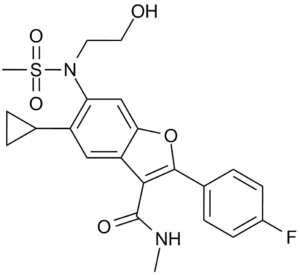Nesbuvir
This product is for research use only, not for human use. We do not sell to patients.

For small sizes, please check our retail website as below: www.invivochem.com
| Size | Price | Stock |
|---|---|---|
| 100mg | $1250 | Check With Us |
| 200mg | $1875 | Check With Us |
| 500mg | $3160 | Check With Us |
Cat #: V18035 CAS #: 691852-58-1 Purity ≥ 99%
Description: Nesbuvir (VB-19796 ; VB19796; HC-V796; HCV796) is a novel and potent NS5B (nonstructural protein 5B) polymerase inhibitor that has the potential for HCV treatment.
Top Publications Citing Invivochem Products
Publications Citing InvivoChem Products
Product Promise

- Physicochemical and Storage Information
- Protocol
- Related Biological Data
- Stock Solution Preparation
- Quality Control Documentation
| Molecular Weight (MW) | 446.49 |
|---|---|
| Molecular Formula | C22H23FN2O5S |
| CAS No. | 691852-58-1 |
| SMILES Code | O=C(C1=C(C2=CC=C(F)C=C2)OC3=C1C=C(C4CC4)C(N(CCO)S(=O)(C)=O)=C3)NC Appearance: Solid powder |
| Synonyms | HCV-796; HCV 796; VB-19796 ; VB19796; HCV796; Nesbuvir. |
| Protocol | In Vitro | Replicon cells are treated with 1 mg/mL G418 and combinations of the two compounds. Nesbuvir (HCV-796) is added to 40 or 80 nM (approximately 10 and 20 times the EC50 in a 3-day replicon inhibition assay, respectively) and Boceprevir is added to 400 or 800 nM (approximately 2 and 4 times the EC50, respectively). The EC50s for Nesbuvir and Boceprevir for the parental replicon in the transient expression assay are comparable to those obtained in the 3-day inhibition assay with the stable replicon cells; the EC50 for Nesbuvir in the transient expression assay is 14 nM, whereas it is 5 nM for the stable replicon; and the EC50 for Boceprevir in the transient expression assay is 608 nM, whereas it is 201 nM for the stable replicon. |
|---|---|---|
| In Vivo | Among a huge variety of yet characterized nucleoside and non-nucleoside inhibitors (NNI), the benzofurane derivative NNI Nesbuvir (HCV-796) is demonstrated to yield significant antiviral effects in mice with chimeric human livers and in patients infected with HCV. HCV-796 binds to a hydrophobic binding pocket at the “palm” domain of NS5B; however, its mode of inhibition remains to be defined. |
These protocols are for reference only. InvivoChem does not
independently validate these methods.
| Solvent volume to be added | Mass (the weight of a compound) | |||
|---|---|---|---|---|
| Mother liquor concentration | 1mg | 5mg | 10mg | 20mg |
| 1mM | 2.2397 mL | 11.1985 mL | 22.3969 mL | 44.7938 mL |
| 5mM | 0.4479 mL | 2.2397 mL | 4.4794 mL | 8.9588 mL |
| 10mM | 0.2240 mL | 1.1198 mL | 2.2397 mL | 4.4794 mL |
| 20mM | 0.1120 mL | 0.5599 mL | 1.1198 mL | 2.2397 mL |
The molarity calculator equation
Mass(g) = Concentration(mol/L) × Volume(L) × Molecular Weight(g/mol)
Mass
=
Concentration
×
Volume
×
Molecular Weight*
The dilution calculator equation
Concentration(start)
×
Volume(start)
=
Concentration(final)
×
Volume(final)
This equation is commonly abbreviated as: C1 V1 = C2 V2
Concentration(start)
C1
×
Volume(start)
V1
=
Concentration(final)
C2
×
Volume(final)
V2
Step One: Enter information below
Dosage mg/kg
Average weight of animals g
Dosing volume per animal µL
Number of animals
Step Two: Enter the in vivo formulation
%DMSO
+
%
+
%Tween 80
+
%ddH2O
Calculation Results:
Working concentration:
mg/ml;
Method for preparing DMSO master liquid:
mg
drug pre-dissolved in
µL
DMSO(Master liquid concentration
mg/mL)
,Please contact us first if the concentration exceeds the DMSO solubility of the batch of drug.
Method for preparing in vivo formulation:
Take
µL
DMSO master liquid, next add
µL
PEG300, mix and clarify, next add
µL
Tween 80,mix and clarify, next add
µL
ddH2O,mix and clarify.
Note:
- (1) Please be sure that the solution is clear before the addition of next solvent. Dissolution methods like vortex, ultrasound or warming and heat may be used to aid dissolving.
- (2) Be sure to add the solvent(s) in order.




































